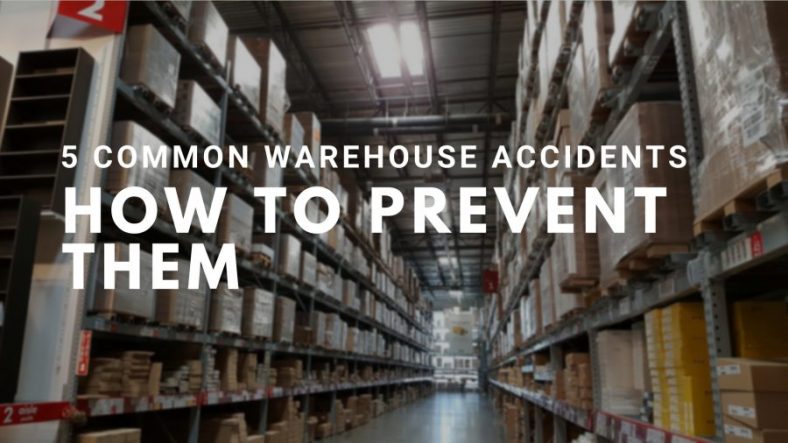In the world of material handling industry, even if the significant hazards are addressed and identified, a careless or small mistake can still result in a dangerous accident. In this article, we’ll discuss five common warehouse hazards that shouldn’t be overlooked.
Accidents on Forklifts
Forklift crashes are frequent in the workplace, whether it’s a novice worker who accidentally takes a wrong turn, or an experienced operator having an off-day. According to the National Institute for Occupational Safety and Health, also known as the NIOSH, the workplace environment, forklift, and the operator’s actions all contribute to having a fatal forklift accident.
As a result, forklift license training, as well as industry-specific hazards, significantly reduces the risk of life-threatening injuries and death. It’s also crucial that vehicles are checked before use to prevent any faulty components that might cause an accident to happen.
Accidents are always bound to happen even in the most unexpected circumstances. Therefore, employers and supervisors must ensure to create steps in creating a work environment that focuses primarily on safety and reduces the risk to employees. With regular training and the right tools, workers are better equipped to identify potential hazards and reduce accidents from happening. These benefits go beyond in limiting injuries and can significantly decrease compensation claims. Doing so drives efficiency and productivity across all business units.
Slips, Trips, and Falls
According to the Occupational Safety and Health Administration, falls, slips, and trips all constitute to the majority of general industry accidents. These are second to vehicular motor accidents that is the leading cause of fatalities, composing of at least 15% of all accidental deaths.
The good news is, these sources of injuries are highly preventable in most cases. Employees should remain alert and uptight at all times by:
- Keeping aisles organized
- Unloading new merchandise immediately on trashing boxes and shelves
- Cleaning liquid spills and removing non-essential ridges and steps
- Putting signs on uneven flooring
- Placing the light on darker areas
- Using anti-slip tape
Rack collapses
Accidents that happen on pallet rock collapses often stem from materials that are not stowed correctly in a safe and orderly fashion. These collapses are dangerous especially when the incident occurs from a high tier or mezzanine since even the smallest item can become a projectile hazard if it falls from a certain height.
One of the best practices is to stack and wrap pallet racks starting from the most prominent and most massive items from the bottom, and the lighter and smaller pieces positioned on the top. The more extensive the load, the more care is required when stacking. Also, pay particular attention to more cylindrical objects as these can easily roll off the shelves and cause serious injuries.
Stacking products high is an efficient way of utilizing space in the warehouse. Though, you must be aware that it can also cause dangerous hazards in the form of falling products ‒ be it an oddly shaped product or a sloppily stored merchandise. The key here is stacking smart.
Also ensure that the pallets have adequate space in between to prevent collapse issues from happening, especially when accessed by lift trucks. Usually, a safety program that regularly inspects pallet racks helps avoid costly accidents from happening.
Spillage and Exposed Harmful Substance
Propane and battery acid are just one of the few harmful substances employees are exposed to on regular workdays. It’s crucial to ensure that all employees are protected and prepared for the exposure of these hazardous substances.
Avoid accidents from happening in the first place by:
- Assuring there is adequate ventilation to disperse fumes from gassing batteries
- Providing employees with adequate protection such as rubber gloves, and eye and face protection
- Strictly enforcing required procedures when refueling propane forklifts and refueling gas
- Utilizing overhead elevators and conveyors for servicing batteries
Ergonomic Strain
An ergonomic strain isn’t just another office phenomenon. In fact, in a warehouse, it’s both painful and real. It’s often associated with both back and foot injuries, and the wear and tear of the body sustain in an injury causes a worker to be out of commission for days, months, and in the most severe cases, indefinitely.
Therefore, employees must have firsthand knowledge and a sense of awareness to be their first line of defense. Employees must not push the limits especially on what they’re capable of, and as much as possible, maintain an open-door policy that’s open to feedback if ever they feel as they are at risk for injury. Everyone should be trained on the floor, even the supervisors themselves ‒ especially on proper lifting techniques.
In Conclusion
No matter how advanced a warehouse’s automation technology is, it’s virtually useless without adequately equipped employees. To have a successful and productive warehouse, employers and supervisors must make safety a priority to ensure everyone stays injury-free at all times.

